This is Part Two of an overview of a twelve night road trip through Tasmania, in winter, 2021. See here for Part One.
Day 7 – Western Creek (Cradle Mountain)
Our plan for the next couple of days was to visit Cradle Mountain, in the Lake St Clair National Park. The snow from the morning was fresh but had started to melt, so going was slow on the road, but worth it once we arrived.
From the Cradle Visitor Centre, you can catch a shuttle bus to various locations for walks and activities. Our first stop was Cradle Mountain Interpretation Centre, where we did a few short walks. The Enchanted Walk, Rainforest Walk and King Billy Walk. While each track was relatively short, the wet snow gave me a run for my money and slowed the pace down a bit. Out and about around the Interpretation Centre and along the walks, we saw a number of wombats; one up very close meandered along in front of us, before diverting off into the grass for a feed.
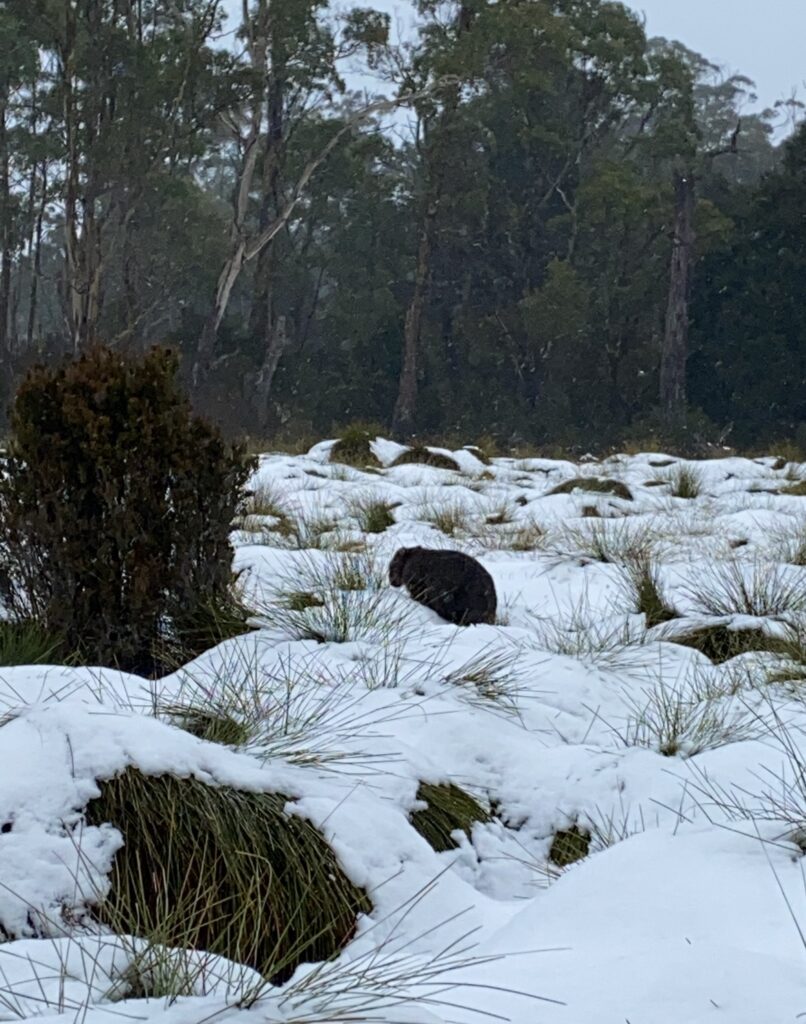
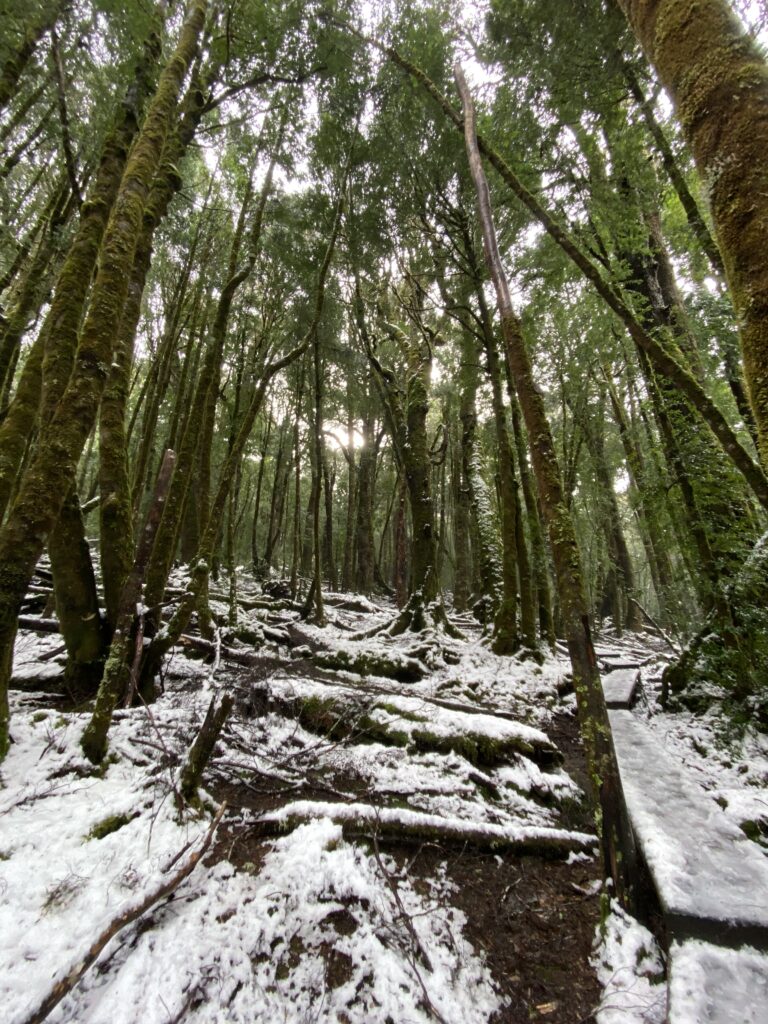
There were a few options for lunch, but we chose the Tavern Bar & Bistro. The food was great but what we really enjoyed was the mulled wine to warm us up.
Onwards from the Interpretation Centre, you can catch the shuttle bus to the Dove Lake area for walks around the lake and surrounding terrain; as well as for the start of the Overland Track, a 65km (one way!) 6-day trek.
It was close to the end of the day for us, so we took the shuttle out to Dove Lake for a short walk up to the Dove Lake Boatshed and back. But we decided from the views we had in that short time, that we would be back the next day!
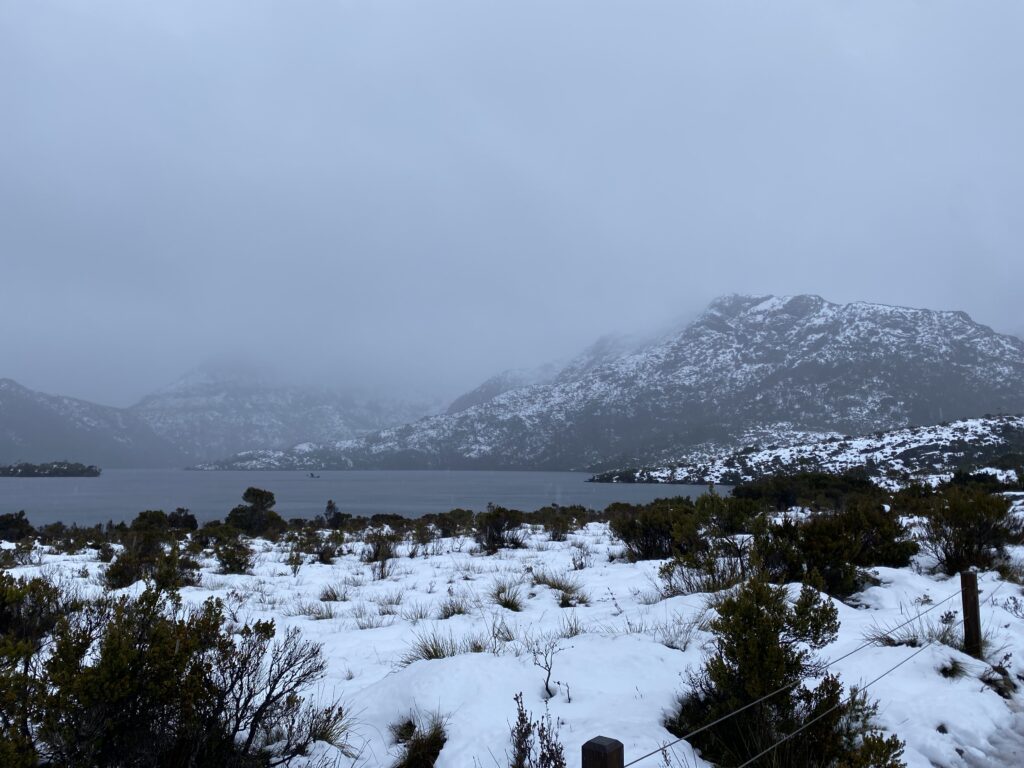
On our drive back to our accommodation, we stopped for dinner at the Settlers Restaurant in Deloraine. The food warmed us up and the venue was cozy and dressed for Christmas in July, with a fireplace burning nearby.
Day 8 – Queenstown
Travel: From Western creek, our next location, Queenstown, was approximately 2.5-3 hours’ drive. However, after a morning at Cradle Mountain, the trek from there was about 1.5 hours.
The next morning, we left our accommodation and on our way to our next location, we stopped for the morning back at Cradle Mountain Visitor Centre, where we hitched the shuttle back to Dove Lake. We did the 6km Dove Lake Circuit. The circuit apparently usually takes about 1.5-2.5 hours – I believe it took us around 2-2.5 and that included stops for photos and to generally just pick our jaws up off the ground.
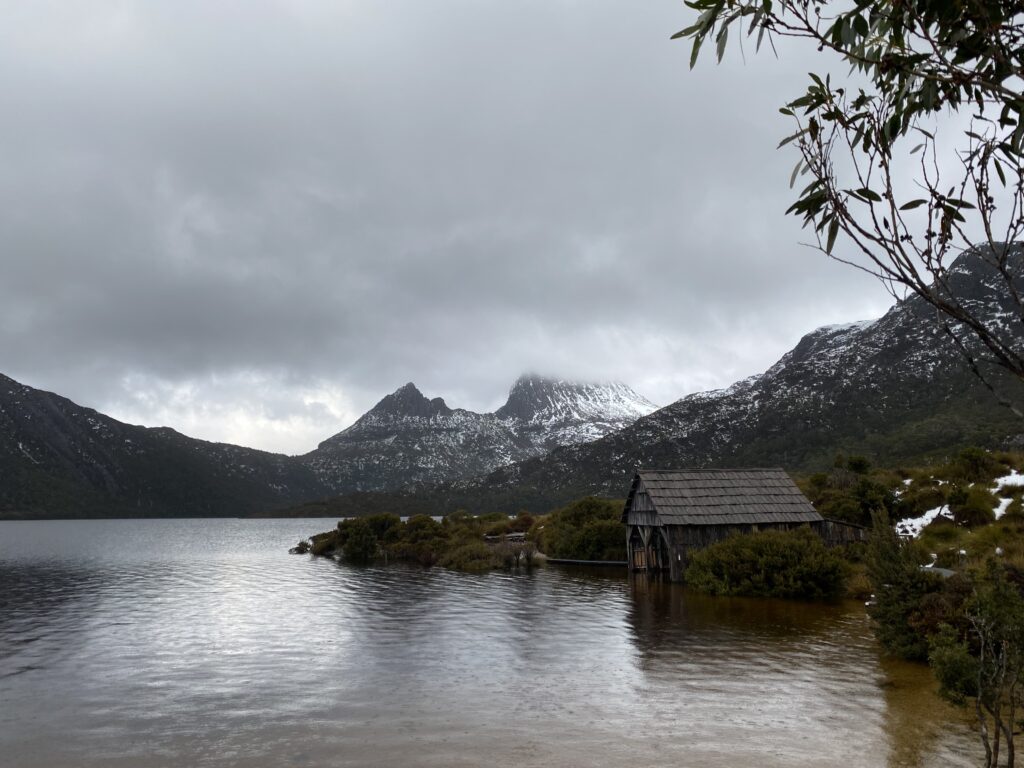
After a long drive, we arrived in Queenstown, a town in the West Coast region, on the western slopes of Mt. Owen. Queenstown holds heritage in the mining industry and the Post Office, dated to 1902, is heritage-listed.
We meandered down to the Empire Hotel for dinner, where the food was great! Curried sausages, can we beat that? (spoiler: no, we can’t).
Accommodation: The Rack @ Rail Cottage (on Airbnb) – a great, spacious location in the middle of town.
Day 9 – Queenstown

We started off the morning having breakfast at Queenstown Station. The West Coast Wilderness Railway is a reconstruction of an historical railway line that stretches between the towns of Queenstown and Strahan, and you can experience this journey through the terrain. We didn’t do this train trip, however, did check out the museum and wandered around the station.
After exploring the town, we took a drive out to Strahan, which today was very quiet. Although this was reflective of much of our trip and was likely due to many Australian states only very recently coming out of a period of COVID lockdown. Anyway, we were not complaining, the quieter the better! And Strahan was picture perfect, sitting quietly on the water.
From there, we were unable to get to our next location, Hogarth Falls, due to very heavy rains and flooding, so we drove on.
We next visited the Iron Blow Lookout, in Gormanston. The area is a testament to overmining, leaving a bizarre – but similarly magnificent landscape. The winding road into and out of the lookout area was a sight! But standing on the lookout walkway was nerve-wracking at times, with the blasting wind that creates a very eerie sound, also feels like it will push you over the edge.
On the way back down the winding road to Queenstown, we stopped for glorious sunset views at the Welcome to Queenstown sign, overlooking the valley.
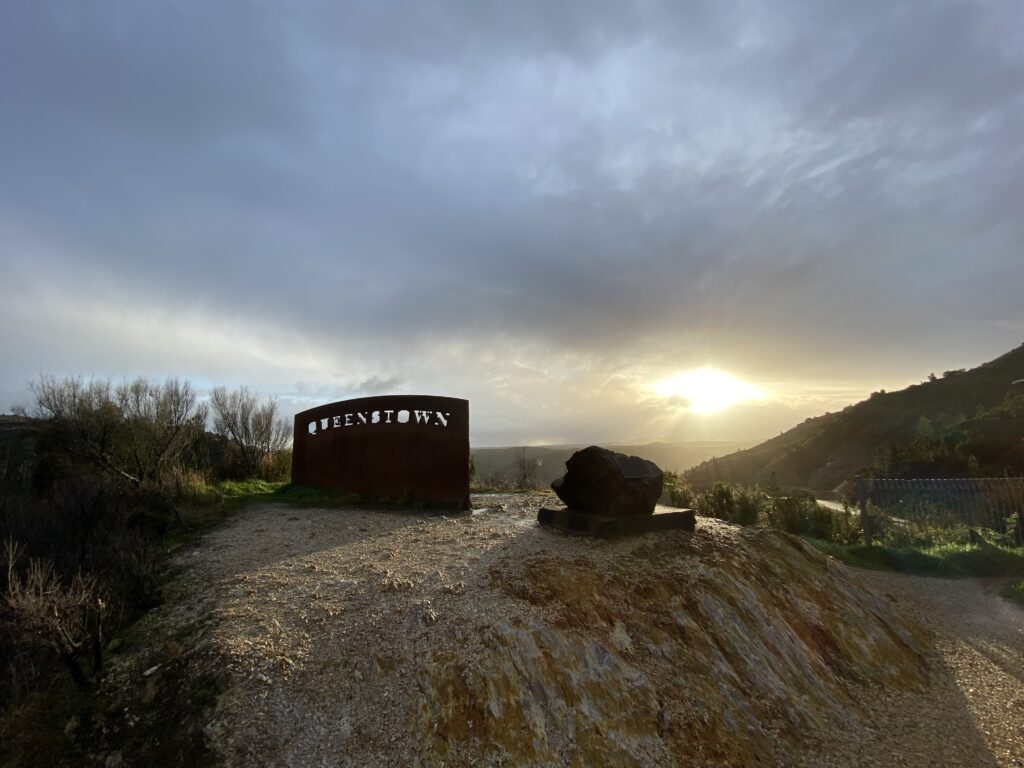
Day 10 – Port Arthur
Travel: Queenstown – Port Arther directly is about a 4.5 hour journey. But to give an overview of some of the stops along the way: Queenstown – Lake St Clair 1hour 30min; Derwent – Richmond 2hours 15min; Richmond – Port Arthur 1hour 15min.
I will make a note that on the first leg of this trip, the roads were closed not long after we drove through, with recent snow fall and icy roads. The drive itself was slow-going and we had to keep an eye on updates and signage. The road we came through on was closed behind us as a tree fell across the way, so we were able to get through just in time!
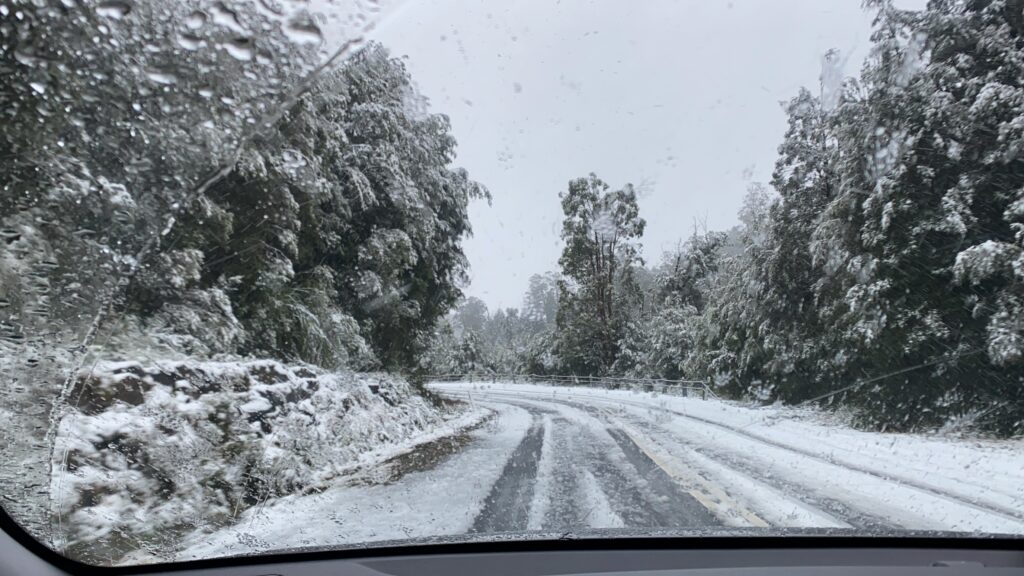
We stopped at Pumphouse Point, located on Lake St Clair. While you can’t reach the pumphouse due to it being part of a (flash) wellness retreat, you can walk along the side of the lake and see it out on the water. We had a stroll, built some tiny snowmen with the remaining snow and headed off.
We arrived in Richmond, a town rich in Tasmanian history and only about half an hour drive from Hobart. We first wandered around, under and over, the Richmond Bridge. This bridge is the oldest still-used bridge in Australia, built by convicts in the 1820s. From my very thorough structural assessment (a wall slap, a walk underneath and a solid stare up), it seemed like it was still doing well.
Richmond is also home of Australia’s oldest remaining Catholic church, St. John’s, which was built in 1836.
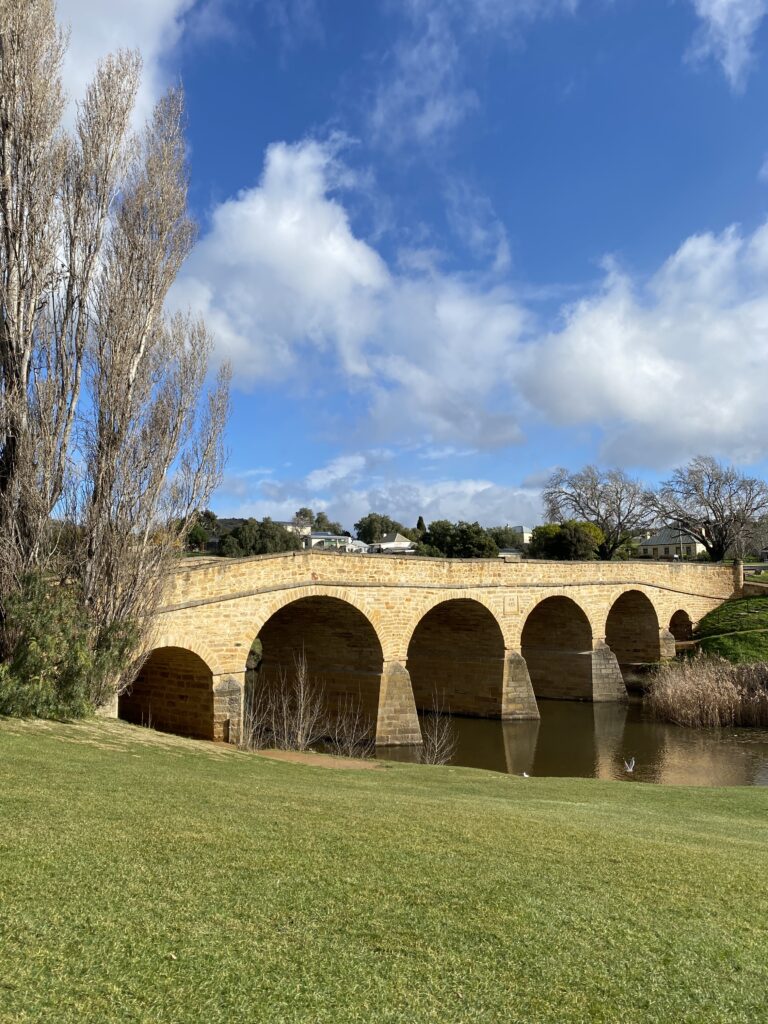
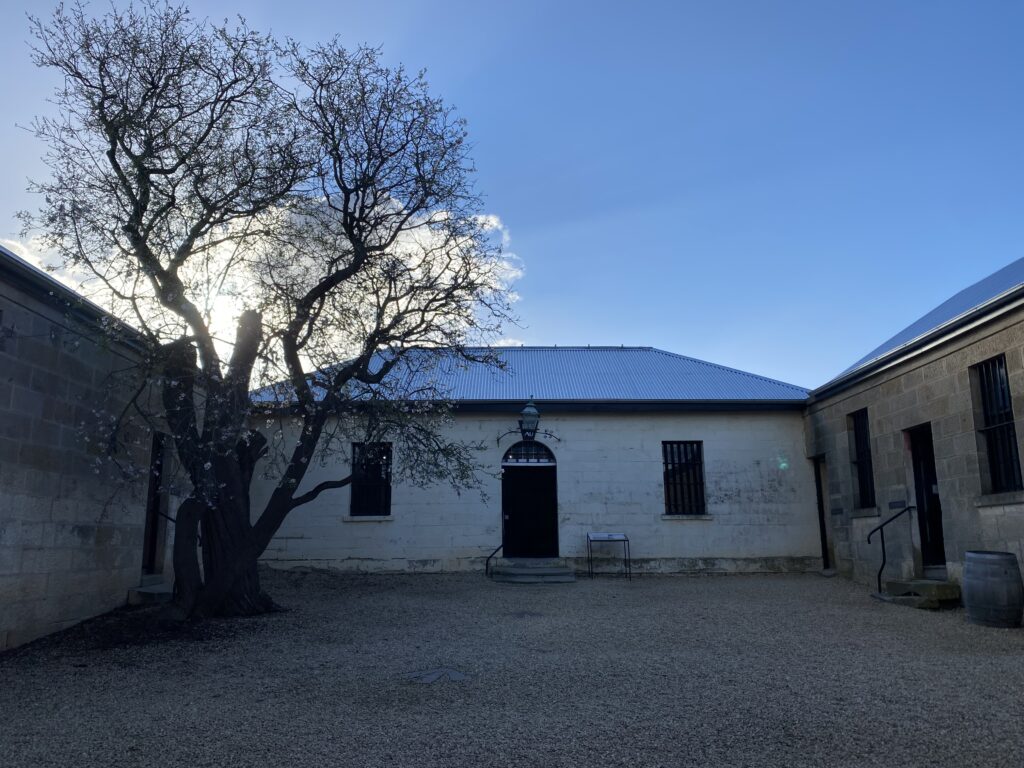
Finally, and something I had been very keen for, we went to the oldest intact jail (gaol… sorry mum), in Australia. The Richmond Gaol dates to 1825 and the site is now an attraction open for public viewing. Thick with history and stories surrounding the building itself, who lived there, who worked there and history of the town, we definitely loitered more than the recommended 45 minutes. Entry was $10 at the time, but I can see from the website it might be now $12.
Richmond is well worth the visit, and we would have liked to have spent more time exploring the shops and cafes around the town. However, we had to head off for our accommodation in Port Arthur, on the Tasman Peninsula.
Accommodation: The Fox and Hounds Historic Hotel, Port Arthur.
Day 11 – Port Arthur
The Port Arthur Historic Site was a whole vibe for me. I had visited once before as a child with my parents, and the spookiness that I recalled from that visit was definitely something I experienced this time around. Although maybe the “spookiness” I felt then could now be interpreted as a thick history and a feeling that there is yet more to be discovered. Archaeologists are actively working on the Port Arthur site and new findings and interpretations of sites are ongoing.
We spent pretty much the whole day at the site. The two-day pass costs $40 each and if you had two days, you would probably USE two days there. Well, we would have anyway.
The number of recovered structures on the site, and the depth that historians, archaeologists and other site staff have gone to in order to recreate these structures and retell their story is staggering.

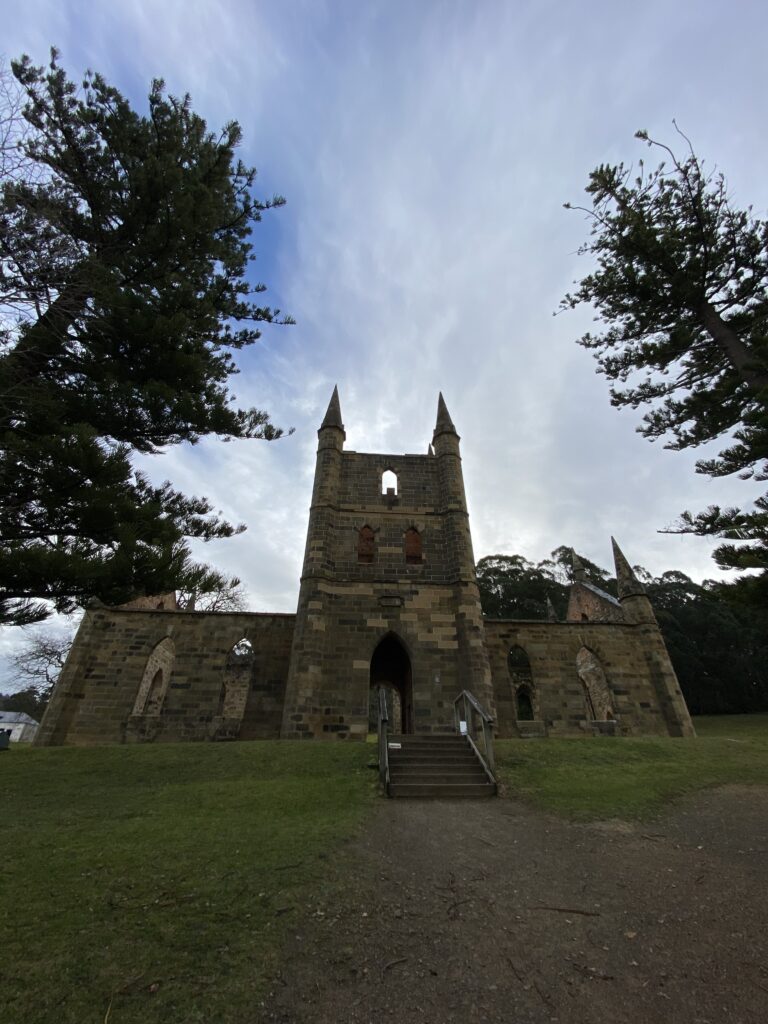
Read more about the Port Arthur historical site here. Or, if you’re interested, and even if you’re not, I will likely talk more about the Port Arthur site another time.
An interesting addition to the site, towards the end of the visit as you near the exit, is an information section. The interesting addition, aside from the information and history, is a small section dedicated to those who have returned taken artifacts from the site in the past. People had returned bricks, rocks and other pieces taken from the site, and often, these were accompanied by a letter or note. A “sorry” that a family member had taken this home; or describing weird or unlucky occurrences sine the item came to their possession.
Something that we did not get to visit, but would have loved to see, was the Isle of the Dead Cemetery, an extra one-hour round trip by boat tour. We chose to use the time we had to explore the main site, however the Isle of the Dead, off the main Port Arthur site, holds significant history in and of itself. It retains a large Aboriginal shell midden site (remains of shells and campfires), as it was used by the Pydarerme people for camping and gathering shellfish prior to British occupation. The site also contains one of the only preserved Australian convict-period burial grounds.
After we left the Port Arthur site, we went to explore the (free to visit) Coal Mines walks. Coal was discovered at Plunkett Point in 1833, and some lucky convicts got to work these bad boys. There are a number of walks around the various spots of interest, inclusive of ruined buildings of barracks and cells and other structures. Part of the site is perched overlooking the water, and when we were there, near sunset, it was a pretty cool sight.
For dinner, we looped back to the 1830 Restaurant and Bar, right near the Port Arthur site. Actually, you can see down onto the sight.
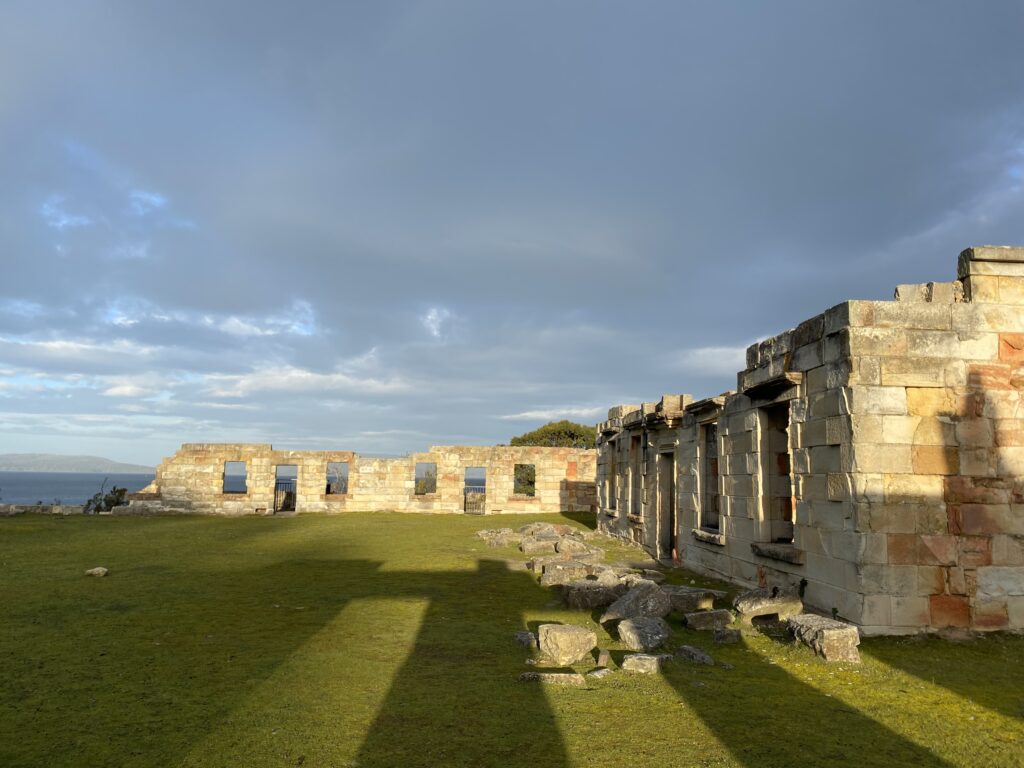
Day 12 – Hobart
Travel: Port Arthur – Salamanca Markets is about 1hour 15min.
Our original plan had involved checking out the Cape Hauy walking track from Fortescue Bay on our way back to Hobart. However, after a very wet night and some last-minute plans to meet family back in Hobart, we headed on back. Although the Cape Hauy track is a round trip of about 9.5kms and 4 hours, so it wasn’t as though my arm had to be twisted too much.

We did make a few stops on our way, though, including to the Blow Hole and nearby Fossil Bay Lookout. A very short trip on and we came to a short stroll leading to a couple of cool sights, Tasmans Arch and Devils Kitchen. These natural sites have been carved out by the the Tasman Sea, and especially during more wild weather, make for a breathtaking site.
Continuing a short way, we came to Eaglehawk Neck, which we actually drove through on our way in towards Port Arthur, however the dark had shielded us from seeing.
The isthmus was used as a place to stop convicts from attempting to leave Port Arthur. Reportedly a line of chained dogs, referred to as the Dog Line, were stationed across the strip of land to alert officers should anyone attempt to cross. Dogs were also stationed on platforms out over the water, to prevent those swimming across – brutal.
We stopped here to learn more about the site and the history of the area at the Officers’ Quarters Museum.
Our last stop along this short space of interesting sites was the Tessellated Pavement. This geological beauty was likely formed over 300 million years ago, with the rocks fractured by movements of the earth and the beautiful outer appearance from ongoing erosion and salt crystallization.
You can view the rocks from the car park and there is also a short walk down.
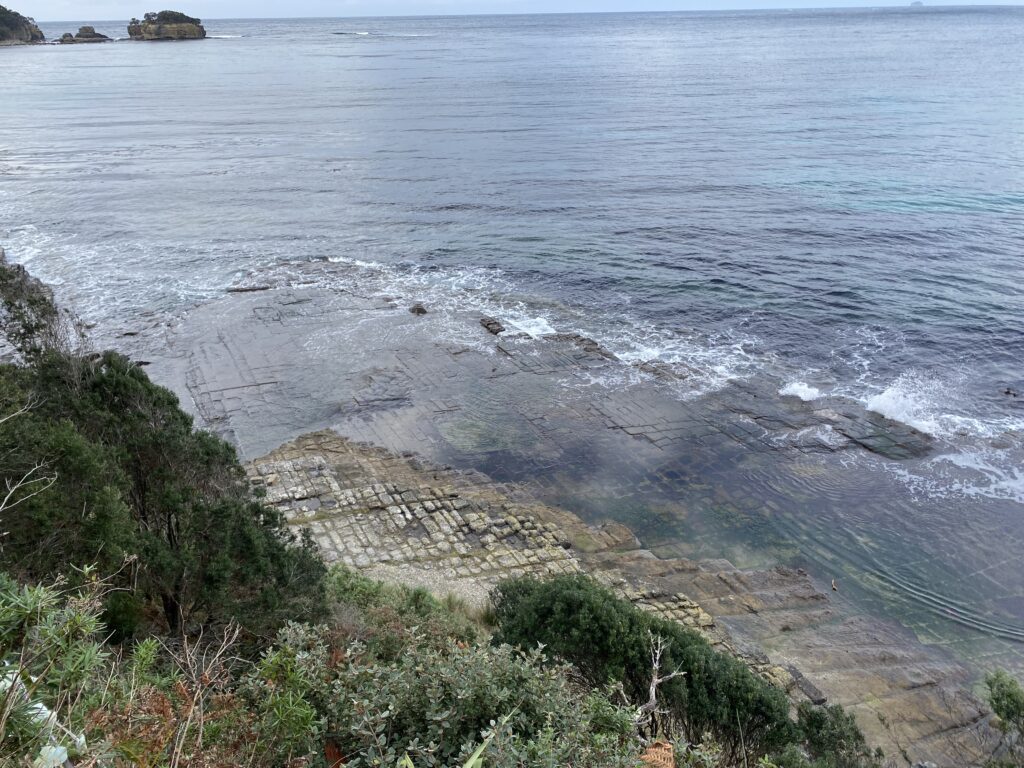
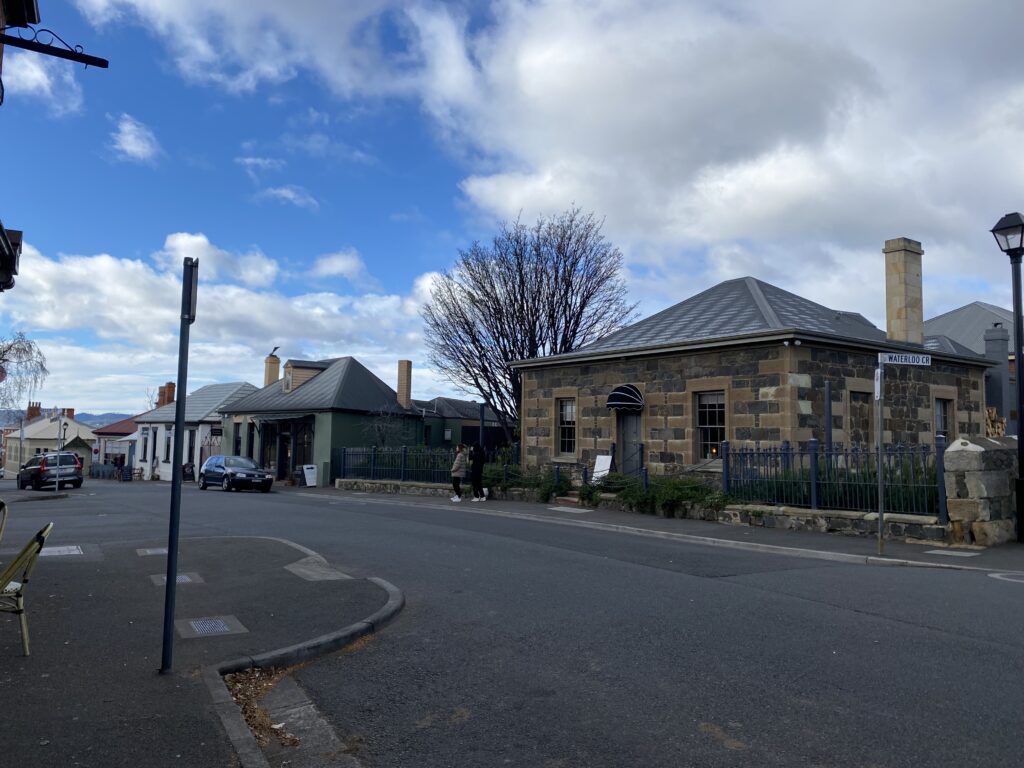
Once back in Hobart, we spent some time at Salamanca Market – an outdoor market held on Saturdays. We followed that up with a couple of afternoon drinks at one of the trendy-looking spots in the area.
Finally, we took an afternoon stroll around the historic suburb of Battery Point, the location of our accommodation (which by the way, is itself an historic feature of the area). Finishing the night off with dinner an drinks at a very trendy bar, called Preachers, which even had a bus parked in the yard for seating.
Accommodation: Prince Of Wales Hotel – situated in the heart of the historic Battery Point. And an historic location of the area.
Day 13 – Hobart
For breakfast we headed to nearby Jackman & McRoss, a super delicious and seemingly popular bakery.
Due to an announcement that morning of a lockdown protocol for those who had recently arrived in Tassie from Queensland, we were advised that we were unable to leave our accommodation, unless for essential travel. Somewhat good timing for us, this morning was really only dedicated to packing up and heading to the airport for our travel home (*weeps*).
Final Statement (*clears throat*)
National park passes need to be purchased for those driving through or entering all national parks in Tasmania. To figure out whether you need a pass, have a look here.
The Kettering barge requires a ticket for travel to and from Bruny Island. According to the Bruny Island website, tickets do not need to be purchased in advance (we didn’t), you just line up as you arrive. Tickets, here, are for a return journey.
Take the opportunity to talk with locals. Staying in an Airbnb and talking to the host, or taking a local tour is a great way to find out places to explore.
Take your time, slow down and take it all in. Tasmania is bigger than most people think, with lots of winding roads, so allow extra time for travel.
Avoid driving long distances at night – there are many animals out and about on the roads, so it is essential to be wary of this for your safety and theirs!
In winter, be mindful of snowfall and the roads, be aware of road closures and recommendations from locals.
If you are exploring in the cooler months, bring clothes you can layer because even the winter sun can be pretty warm. And closed in shoes are a must if you plan on doing any sort of walking!
If you plan on camping or are driving a van, research free camping spots before you set off on your adventure – there are plenty of sites sharing this information.
If you have any Tasmanian tips or adventures to share (for our next trip there!) please let me know! Drop a comment or reach out 🙂.
Subscribe below for more travel posts and tips!